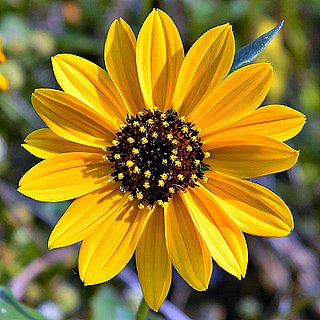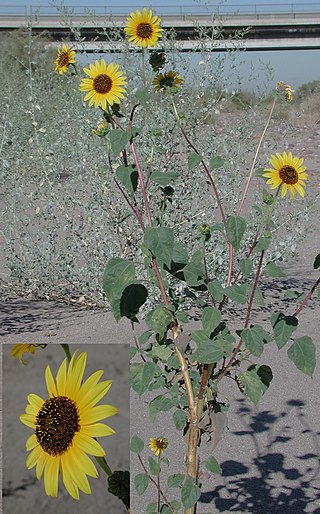
Vigna is a genus of plants in the legume family, Fabaceae, with a pantropical distribution. It includes some well-known cultivated species, including many types of beans. Some are former members of the genus Phaseolus. According to Hortus Third, Vigna differs from Phaseolus in biochemistry and pollen structure, and in details of the style and stipules.

Pinus contorta, with the common names lodgepole pine and shore pine, and also known as twisted pine, and contorta pine, is a common tree in western North America. It is common near the ocean shore and in dry montane forests to the subalpine, but is rare in lowland rain forests. Like all pines, it is an evergreen conifer.

Helianthus is a genus comprising about 70 species of annual and perennial flowering plants in the daisy family Asteraceae commonly known as sunflowers. Except for three South American species, the species of Helianthus are native to North America and Central America. The best-known species is the common sunflower, whose round flower heads in combination with the ligules look like the Sun. This and other species, notably Jerusalem artichoke, are cultivated in temperate regions and some tropical regions, as food crops for humans, cattle, and poultry, and as ornamental plants. The species H. annuus typically grows during the summer and into early fall, with the peak growth season being mid-summer.

Alnus incana, the grey alder or speckled alder, is a species of multi-stemmed, shrubby tree in the birch family, with a wide range across the cooler parts of the Northern Hemisphere. Tolerant of wetter soils, it can slowly spread with runners and is a common sight in swamps and wetlands. It is easily distinguished by its small cones, speckled bark and broad leaves.

Helianthus nuttallii, or Nuttall's sunflower, is a species of sunflower native to northern, central, and western North America, from Newfoundland west to British Columbia, south to Missouri, New Mexico, and California.

Helianthus pauciflorus, called the stiff sunflower, is a North American plant species in the family Asteraceae. It is widespread across the Great Plains, the Rocky Mountains, and the Great Lakes region, and naturalized in scattered locations in the eastern United States and in much of southern Canada.

Chrysothamnus viscidiflorus is a species of shrub in the family Asteraceae of the Americas known by the common names yellow rabbitbrush and green rabbitbrush.

Chlosyne lacinia, the bordered patch or sunflower patch, is a North and South American butterfly in the family Nymphalidae.

Helianthus occidentalis, the fewleaf sunflower or western sunflower, is a species of sunflower native to the Eastern and Central United States. It grows mostly in the Great Lakes Region and in the Ozarks, with additional populations scattered as far as Massachusetts, Texas, and the Florida Panhandle.

Helianthus petiolaris is a North American plant species in the family Asteraceae, commonly known as the prairie sunflower or lesser sunflower. Naturalist and botanist Thomas Nuttall was the first to describe the prairie sunflower in 1821. The word petiolaris in Latin means, “having a petiole”. The species originated in Western United States, but has since expanded east. The prairie sunflower is sometimes considered a weed.

Helianthus debilis is a species of sunflower known by the common names cucumberleaf sunflower, beach sunflower, weak sunflower, and East Coast dune sunflower. It is native to the United States, where it can be found along the Atlantic and Gulf Coasts. It is known elsewhere as an introduced species, such as South Africa, Australia, Taiwan, Slovakia, and Cuba.

Village Creek is a blackwater tributary of the Neches River in Texas, United States. It arises in northwestern Hardin County outside the community of Village Mills. Due to the waterway's isolation and absence of impoundments, it is known to be pristine supporting cypress swamps and hardwood forests, as well as many rare and endangered species. It is 63 miles (101 km) long and average streamflow at the mouth is approximately 1,000 cubic feet per second (28 m3/s). It passes through three conservation areas on the way south, being: the Big Thicket National Preserve - Village Creek Corridor Unit, Roy E. Larsen Sandyland Sanctuary, and Village Creek State Park.

Helianthus anomalus, the western sunflower, is a species of plants in the family Asteraceae, found in the southwestern United States.

Palmerella is a genus of plants in the family Campanulaceae. It has only one known species, Palmerella debilis, long known by the synonym Lobelia dunnii. It is native to 8 counties in southern California plus the northern part of Baja California.

Helianthus eggertii, known as Eggert's sunflower, is a North American species of flowering plants in the family Asteraceae. It is native to Tennessee, Kentucky, South Carolina, and Alabama. It is best known as one of the few plants to have been delisted under the Endangered Species Act because of the species' recovery. It was described by John Kunkel Small in 1903.
Helianthus neglectus is a species of sunflower known by the common names neglected sunflower. It is native to the southwestern United States in southeastern New Mexico and West Texas.
Helianthus nuttallii subsp. parishii is a subspecies of the species Helianthus nuttallii in the genus Helianthus, family Asteraceae. It is also known by the common names Los Angeles sunflower and Parish's sunflower. This subspecies has not been seen, in the wild or in cultivation, since 1937.
Helianthus nuttalliisubsp. nuttallii, also known by the common name Nuttall's sunflower is a subspecies of Helianthus nuttallii in the genus Helianthus in the family Asteraceae. It is considered by The Plant List to be a synonym for H. nuttallii. However, The Jepson Manual argues that it is distinct from the species.















